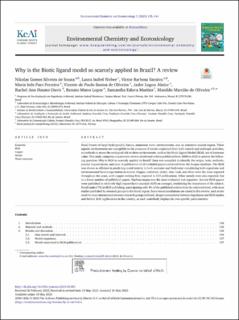| dc.contributor.author | de Souza, Nikolas Gomes Silveira | |
| dc.contributor.author | Weber, Laura Isabel | |
| dc.contributor.author | Saraiva, Victor Barbosa | |
| dc.contributor.author | Ferreira, Maria Inês Paes | |
| dc.contributor.author | de Paulo Santos de Oliveira, Vicente | |
| dc.contributor.author | Júnior, Jader Lugon | |
| dc.contributor.author | Hauser-Davis, Rachel Ann | |
| dc.contributor.author | Lopes, Renato Matos | |
| dc.contributor.author | Martins, Samantha Eslava | |
| dc.contributor.author | de Oliveira, Manildo Marcião | |
| dc.date.accessioned | 2024-02-12T13:19:43Z | |
| dc.date.available | 2024-02-12T13:19:43Z | |
| dc.date.created | 2023-11-08T10:44:58Z | |
| dc.date.issued | 2023 | |
| dc.identifier.citation | Environmental Chemistry and Ecotoxicology. 2023, 5, 135-144. | en_US |
| dc.identifier.issn | 2590-1826 | |
| dc.identifier.uri | https://hdl.handle.net/11250/3117023 | |
| dc.description.abstract | Brazil boasts of large hydrographic basins, numerous lentic environments, and an extensive coastal region. These aquatic environments are susceptible to the presence of metals originated from both natural and anthropic activities, so methods to assess the ecological risk to these environments, such as the Biotic Ligand Model (BLM), are of immense value. This study comprises a systematic review of selected articles published from 2008 to 2020 to answer the following question: Why is BLM so scarcely applied in Brazil? Data was compiled to identify the origin, tests, methods, journal impact factor, and year of publication of all included papers retrieved from the Scopus database. The BLM was shown as efficient in predicting metal toxicity in both seawater and freshwater considering both organisms and environmental factors (speciation in water). Copper, cadmium, nickel, zinc, lead, and silver were the most reported throughout the years, with copper ranking first, reported in 133 publications. Other metals were also reported, but in a lower number of published papers. Daphnia magna was the most evaluated test organism. Several BLM papers were published in relatively high impact factor journals (4,93 on average), reinforcing the importance of the subject. Brazil ranked 7th in BLM publishing, participating with 4% of the published articles from the retrieved total, with most studies published by research groups in the South region. Some recommendations are raised in this review, such as the need for more interactions between research groups in Brazil, deeper connectivity between legislation and BLM studies and further BLM applications in the country, as each waterbody displays its own specific particularities. | en_US |
| dc.language.iso | eng | en_US |
| dc.publisher | Elsevier | en_US |
| dc.rights | Attribution-NonCommercial-NoDerivatives 4.0 Internasjonal | * |
| dc.rights.uri | http://creativecommons.org/licenses/by-nc-nd/4.0/deed.no | * |
| dc.title | Why is the Biotic ligand model so scarcely applied in Brazil? A review | en_US |
| dc.type | Peer reviewed | en_US |
| dc.type | Journal article | en_US |
| dc.description.version | publishedVersion | en_US |
| dc.rights.holder | © 2023 The Authors | en_US |
| dc.source.pagenumber | 135-144 | en_US |
| dc.source.volume | 5 | en_US |
| dc.source.journal | Environmental Chemistry and Ecotoxicology | en_US |
| dc.identifier.doi | 10.1016/j.enceco.2023.05.001 | |
| dc.identifier.cristin | 2193755 | |
| cristin.ispublished | true | |
| cristin.fulltext | original | |
| cristin.qualitycode | 1 | |

